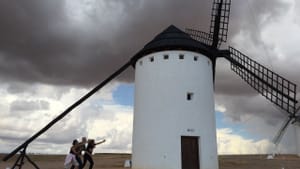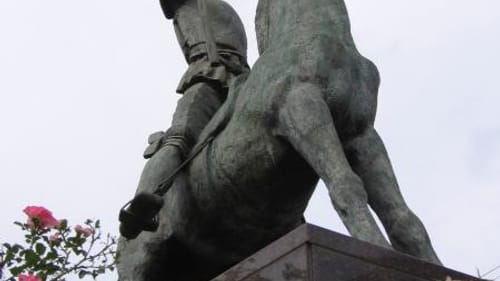Stay in the Loop
BSR publishes on a weekly schedule, with an email newsletter every Wednesday and Thursday morning. There’s no paywall, and subscribing is always free.
Don Quixote finds a voice
Piffaro brings back the music of Golden Age Spain

The Spanish Golden Age: the very name conjures up an entrancing lost world, glittering, shrouded, and beckoning.
Which is about right. It’s a fabled moment in Spanish culture, right at the beginning of the 1600s, a time of great wealth and big dreams — in principle. In reality, the Spanish Golden Age marked the beginning of the end. In 1600, Spanish troops were still spreading across the globe. Gold and silver poured in from the New World. But the age of the conquistadores was over and in the next few decades, Spain’s overgrown empire would start to fall apart.
It was going out with a bang, though. The Golden Age may have been a swan song, but it was gorgeous. What’s bad for society can be good for artists. Crazy-rich nobles were spending like there was no tomorrow. The arts were flourishing; theater was exploding. Lope de Vega wrote more than 1,000 plays, many of them successful, many of them good. Song and all of that amazing Spanish dance was everywhere. And Miguel de Cervantes finished one of the towering masterpieces of world literature, The Ingenious Gentleman Don Quixote of La Mancha, just before his death in 1616.
“There’s a big change,” says Robert Wiemken of Philadelphia’s Piffaro, the Renaissance Band of Spanish Golden Age music. “Rhythms go wild, there’s a real sense of breaking barriers.” Don Quixote was not alone. It came from a rich culture, although we think of it in isolation.
Revisiting a former world
Wiemken and Piffaro artistic codirector Joan Kimball are in the midst of preparing a major project, The Musical World of Don Quixote, which will give us a chance to experience what’s been in Don Quixote’s shadows all these years. The sounds of Spain’s Golden Age will ring out again come October.
It’s a major undertaking for the group, with concerts, exhibitions around the city, and a symposium at the University of Pennsylvania’s Kislak Center. When it’s in full swing, there’ll be full immersion in Spanish music of the 1600s.
That’s six months away. This afternoon in March, around a long table increasingly littered with books and papers, Kimball and Wiemken are spitballing on how the show will work. “It’ll be organized around the book,” Kimball says. “But not just the book,” Wiemken replies. “Right, the book and what’s outside the book.”
The book is the core. Four hundred years old, Don Quixote is still everywhere. That crazy old coot setting off to save the world on a broken-down nag, skeptical pal Sancho Panza by his side, is immortal. Don Quixote is as up-to-date as the next time someone talks about “tilting at windmills,” or calls a wild-eyed dream “quixotic” — which is basically every day.

“This project resonates like crazy,” says Kimball. “You say ‘Don Quixote’ and you can see eyes widen and the light bulbs pop. It’s such a signature thing, this icon in Western culture. It just draws people in.”
Music, silenced
But Golden Age music? Until very recently, it had just faded away. It’s nobody’s fault. That’s what happened in those days. Back before Bach, music didn’t have “classics.” Fashions changed fast and old music, in this case Spanish Golden Age music, got stuffed into dusty archives and forgotten. Even the distinctive Spanish instruments of the time — chiramias, bajónes, sacabuches, and vihuelas — morphed into modern oboes, bassoons, trombones, and guitars and disappeared, too.
But now, it’s b-a-a-a-c-k, and it’s back here in Philadelphia. And thanks to Piffaro’s eminence in the world of Renaissance music performance, it really couldn’t be anyplace else.
On the face of it, we’re an unlikely location. We don’t have Renaissance monuments here. We don’t have a Renaissance heritage industry as in Europe. In 1600, we were a forest. “Quixotic” might well have been just the word to describe Kimball’s and Wiemken’s vision when they started a Renaissance wind band here in the ’80s.
Thirty years of incubation
But Philadelphia turned out to be nurturing. Thirty years here has given the group time and space to dive into the old repertoire, figure out how to make the original instruments play clean and sweet again, put shows together, and make important recordings. The group has 18 CDs to their credit, including four in the ’90s on the Deutsche Grammophon/Archiv Produktion label, which were game-changers for reputation and international recognition.
Piffaro is another of those unexpected gems that gives Philadelphia its distinctive character, like the Barnes Foundation or Bloomsday at the Rosenbach. It’s not until you’ve been away for a while that you realize that other cities don’t have regular fare like Piffaro’s programs this spring, Mummer’s Delight: A Renaissance Menagerie and Harmony of the Spheres: An Adventure in Space and Time.
Back to the source
A grant from the Pew Center for Arts and Heritage is helping support the program and research. Last fall, Wiemken, Kimball, and co-Piffarites Priscilla and Grant Herreid took their own Quixote tour of Spain. They pored over manuscripts and met up with Spanish colleagues. In Lerma, they caught a glimpse of street paraders who still play chiramias, a thrilling moment. And in an off-the-beaten path music store in Madrid, they found a set of modern Spanish bagpipes — a gaita, not so very different from their own historical pipes — and couldn’t resist buying them.
This spring, if you’re walking around Fairmount Avenue near Piffaro’s typically-Philadelphia modest brick rowhouse office, you just might hear those pipes blaring out of a window, letting off a great, raucous, 17th-century Spanish imperial peal over sidewalks and bemused passers-by.
Consider it a preview.
Editor's note: This article is the first in a series about Piffaro's work in progress, leading up to the October debut. The series is being presented on Broad Street Review in partnership with Piffaro.
To read the second article in this series, click here.
To read the third article in this series, click here.
What, When, Where
The Musical World of Don Quixote. Piffaro, the Renaissance Band, with special guest artists New York Polyphony; Nell Snaidas (soprano, guitar); Glen Velez, percussion; Charlie Weaver (guitar, vihuela); Eric Schmalz (sackbut). October 7 to 9, 2016. Concerts at Philadelphia Episcopal Cathedral, 23 South 38th Street, Philadelphia, and symposium at the University of Pennsylvania’s Kislak Center for Special Collections. piffaro.org
For more information about The Musical World of Don Quixote concerts and programs, click here.
Sign up for our newsletter
All of the week's new articles, all in one place. Sign up for the free weekly BSR newsletters, and don't miss a conversation.

 Anne Schuster Hunter
Anne Schuster Hunter